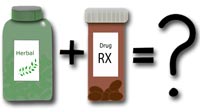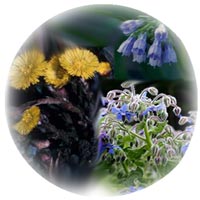Botanical Medicine

Are Botanical Medicines Safe?
This, of course, is the big question. And, of course, it can't be answered generally. You must consider the potential benefits and risks of a specific botanical for your specific situation. As with drugs, you need to consider any contraindications, such as allergies. If you are taking other drugs or botanicals, you need to research possible drug interactions.
As the amount and quality of scientific research regarding botanicals increases, it is getting easier to find this information. Do note, however, that scientists have not systematically studied the use of botanical medicine in special populations, such as infants, children, pregnant or lactating women, the elderly, and the critically ill. (Nor have they studied the use of most pharmaceutical medicines in these special populations.)
Click on a topic below to learn more.
- What is your job?
- What does the government do?
- How big a risk are adverse reactions?
- What else should I know about adverse reactions?
- Useful references
What is your job?
Ensuring your safety is ultimately your job. You need to take responsibility for the following.
Be informed. Always research the benefits and risks before taking any botanicals. Pay particular attention to contraindications and reported adverse reactions. Make sure you research the botanical for your intended use and for any special considerations that apply to you, such as allergies, other health issues, and any other drugs or botanicals you are taking, so you can avoid possible drug-botanical interactions. (See What Else Should I Know About Adverse Reactions? below.) You can find good books and websites to help you in our Resources section.
Talk to your healthcare provider. Even if you think your provider might be uncomfortable with botanicals, don't let that discourage you--you need to partner with your provider! Tell your provider what you are considering and share what you have discovered from your research. Explain why you are interested in using botanicals.
You should expect your health provider to be respectful, to listen actively and answer your questions, and to partner with you on diagnostic and treatment decisions. Your provider's input is invaluable because he or she knows your health particulars and the drugs you are taking.
 Because so many people are now using botanical medicines, healthcare providers should make the effort to get some information regarding the effects, benefits, and risks of botanicals. Many have done so, but it is still sometimes difficult to find an informed healthcare provider or pharmacist who can advise you. If your provider is open to learning more, one good primary source of information is PubMed, a free online database that is maintained by the National Library of Medicine.
Because so many people are now using botanical medicines, healthcare providers should make the effort to get some information regarding the effects, benefits, and risks of botanicals. Many have done so, but it is still sometimes difficult to find an informed healthcare provider or pharmacist who can advise you. If your provider is open to learning more, one good primary source of information is PubMed, a free online database that is maintained by the National Library of Medicine.
If you don't feel that you can partner successfully with your provider, you might want to consider finding one that you can work with. As much as you can within the limits of your health insurance, choose a provider or clinic where you feel you can get your needs met and where you feel comfortable.
Buy good quality botanicals. We cover this in more detail in How Can I Find Good Quality Botanicals?, but essentially you want to buy from manufacturers who adhere to good manufacturing standards, such as those certified by USP or NSF International.
Follow recommendations for usage. Read labels carefully. Compare the dosage and other recommendations with your own research, as well as that of your provider. Pay attention to cautions and contraindications, which are situations where botanicals are not recommended.
Back to top
What does the government do?
Botanical Botanical medicines are called dietary supplements by the federal government and regulated under the Dietary Supplement Health and Education Act (DSHEA) and the Dietary Supplement and Non-prescription Drug Consumer Protection Act. These regulations differ from those for drugs (both prescription and over-the-counter).
The FDA does not pre-approve supplements
While drugs need to go through clinical evaluation to determine their efficacy and safety for specific uses before they get Federal Drug Administration (FDA) approval for sale, dietary supplements do not. (The exception to this is if the supplement includes a dietary ingredient that was not sold in the U.S. before 1994.)
Under DSHEA, manufacturers are responsible for determining that their supplements are safe and that their product claims are backed by evidence. The 2006 Dietary Supplement and Non-prescription Drug Consumer Protection Act added more rigorous oversight of dietary supplements and mandated reporting of serious adverse events associated with dietary supplements and over-the-counter products.
Under this newer law, all serious adverse events must be reported to the FDA within 15 days. In most instances, this law mandates the manufacturers, packers, or distributors of the products to file the report, but retailers are also required to report adverse events if their name appears on the label of the dietary supplement, or if they have entered into agreements with the manufacturers or distributors to accept responsibility for submitting adverse event reports.
In 2007, the Federal Drug Administration (FDA) announced a final rule establishing current good manufacturing practice requirements for dietary supplements. The final rule requires manufacturers to report all adverse events to the FDA, as well as evaluate the identity, purity, quality, strength, and composition of its dietary supplements. This change places more accountability on the industry and should increase consumers' confidence in the quality of dietary supplements, according to the FDA.
Responsible manufacturers of dietary supplements will be up front about the possible risks and contraindications of their products. Most of these companies belong to the American Herbal Products Association (AHPA), which encourages its members to follow responsible marketing and ethical standards. If a company is not listed on the AHPA website, see it as a "red flag" and avoid purchasing that company's products.
The FDA can stop the sale of supplements
The FDA has the authority to remove a product or ingredient from market if there is an "imminent hazard" to consumers (Henney, 1999). This happened in 2004 with supplements containing ephedra, an herbal stimulant used in weight loss and performance products that had been linked to adverse reactions and several fatalities.
The FDA may also remove dietary supplements if they are:
- "Adulterated" due to contamination, whether or not the adulteration poses a risk of injury.
- "Misbranded" because there are undeclared ingredients in the product.
Examples of DSHEA enforcement
From 2002 to 2008, the FDA:
- Conducted 909 domestic inspections of dietary supplement manufacturers
- Issued 293 warning letters and "cyber-letters" to supplement marketers
- Detained 3,225 imported dietary supplements. For the products detained without physical examination, 32.5% were botanical and herbal products other than teas, and 23.3% were botanical and herbal teas.
How big a risk are adverse reactions?
The 2006 Dietary Supplement and Non-prescription Drug Consumer Protection Act added more rigorous oversight of dietary supplements and mandated reporting of serious adverse events associated with dietary supplements and over-the-counter products.
But this is not to say that there have been large problems with botanical safety. While serious adverse reactions to botanicals have been reported from time to time, botanicals typically possess an inherently wide margin of safety (Farnsworth, 1993). Most adverse reactions are produced by a small number of botanicals.
Data from the American Association of Poison Control Centers Toxic Event Surveillance Database supports this. A study compared the adverse events due to one botanical, ephedra, to that for all other botanical medicines. Ephedra products were responsible for 64 percent of adverse reactions but accounted for only 0.82 percent of total sales (Bent, 2003). In April 2004, the FDA issued a ban on all dietary supplements containing ephedra.
Since the ephedra ban in 2004, numerous alternative products, such as bitter orange extracts containing synephrine, have been introduced to fill the void. While information on the safety and efficacy of these alternative products is generally lacking, there has not been a dramatic upturn in reported adverse reactions that can be attributed to the marketing of these ephedra alternatives (Seamon & Clauson, 2005).
Compare adverse reactions in pharmaceuticals and botanicals
| Pharmaceuticals | Botanicals (Dietary Supplements) |
|
Adverse drug reactions to pharmaceutical medications were responsible for more than 100,000 fatalities per year, while non-fatal adverse reactions serious enough to warrant hospitalization were reported for approximately 2.2 million cases (Lazarou, 1998). These statistics apply only to adverse drug reactions in which the medication was appropriately used. This places adverse reactions to pharmaceuticals as the fifth leading cause of mortality in the U.S. |
Reported fatalities from adverse reactions to botanical supplements range from less than 12 to 24 (at most). Admittedly, adverse reactions to dietary supplements are not as well monitored as for pharmaceuticals. Even allowing for under-reporting, however, the documented number of serious or life-threatening adverse reactions to botanical medicines remains extremely low. |
What else should I know about adverse reactions?
 Most of the adverse effects associated with botanicals are mild or pose minimal potential for serious consequences. One group of adverse reactions is preventable if consumers pay attention to dosage, contraindicated usage, and possible allergic reactions. Another group of more serious adverse reactions due to contamination and misidentification are fortunately quite rare.
Most of the adverse effects associated with botanicals are mild or pose minimal potential for serious consequences. One group of adverse reactions is preventable if consumers pay attention to dosage, contraindicated usage, and possible allergic reactions. Another group of more serious adverse reactions due to contamination and misidentification are fortunately quite rare.
But that is not to say that you shouldn't be aware of potential issues that can arise with specific medical conditions or interactions with drugs. Once again, you should discuss concerns with a knowledgeable practitioner to determine if you are at risk.
Below are the possible causes of adverse reactions.
Allergic reactions
Allergic reactions are a possibility, just as they are with many foods and pharmaceuticals. If you have allergies, look for contraindications in the research and consult with your healthcare provider.
Improper dosage or contraindicated usage
Adverse reactions may also result from inappropriate or improper usage, such as excess dosage. In these cases, the fault lies not with the botanical supplement, but with a failure of communication. Similar errors occur with pharmaceutical medicines; in both cases, the solution includes proper education and effective communication.
Food/drug interactions
In practice, the most frequent adverse reactions to botanical medicines typically originate from interactions with prescription medicines, other dietary supplements, or in some cases, with foods.
Brinker (1998) has identified the most potentially serious or life-threatening botanical/pharmaceutical interactions, wherein the botanical:
- Affects absorption of drugs
- Enhances potassium loss if given with diuretics
- Interacts with monoamine oxidase inhibitors
- Interacts with cardiac glycosides
- Enhances effects of barbiturates
- Alters effects of blood sugar medications
- Interacts with anticoagulant (blood thinning) medications
The bottom line is that you should always check with your provider before taking botanicals, especially if you are taking other medications.
As an aside, not all botanical/pharmaceutical interactions are harmful. For example, in some cases, botanicals can enhance the effect of a pharmaceutical, thus allowing individuals to reduce their dosage. Again, this is one of those "grey areas" where a conversation with your informed healthcare provider can help. You should not discontinue or change the doses of a prescribed pharmaceutical medicine without first discussing it with your healthcare provider.
Contamination & adulteration
Occasionally, supplements are contaminated with unwanted constituents, such as heavy metals, or even deliberately adulterated with pharmaceutical ingredients. Such failures in quality control are extremely rare, but when they do occur, they can be serious. These types of safety hazards are seen more frequently in herbal supplements imported from India, China, or other countries where quality control procedures are less stringent than in this country.
You should research manufacturers and look for those who adhere to good manufacturing standards, such as those certified by USP or NSF International.
If you want to go into more depth, the American Association of Analytical Chemists provides important technical information on the analytical methods used in the evaluation of dietary supplements.
Misidentification
Occasionally the wrong botanical ingredient is in a dietary supplement because the plant was misidentified or an incorrect plant was incorporated into the supplement along with the correctly identified ingredient. When the misidentified plant is non-toxic, the adverse consequences are relatively minor, other than the fact that you may not receive the therapeutic benefit. When a toxic plant is accidentally substituted for another botanical, however, the adverse consequences can be significant. Fortunately, such occurrences are extremely rare.
Once again, it is a good idea to research manufacturers and look for those who adhere to good manufacturing standards, such as those certified by USP or NSF International. The good news is that the FDA issued mandated guidelines to implement Good Manufacturing Practice standards for the manufacture of dietary supplements in 2007 (Cavalier & Blumenthal, 2007). Hopefully these more stringent standards will resolve many of the issues surrounding the quality of botanical dietary supplements.
Toxic ingredients
 Botanical supplements containing toxic constituents, such as liver toxins or carcinogens (chemicals with potential to cause cancer), do occasionally cause adverse reactions, but as a rule, these supplements are quickly withdrawn from the market once a potential problem has been identified. Some may still be sold in supplements imported from Asia or Europe.
Botanical supplements containing toxic constituents, such as liver toxins or carcinogens (chemicals with potential to cause cancer), do occasionally cause adverse reactions, but as a rule, these supplements are quickly withdrawn from the market once a potential problem has been identified. Some may still be sold in supplements imported from Asia or Europe.
The following is a partial list of botanicals with potentially toxic constituents:
- Borage
- Calamus
- Chaparrel
- Coltsfoot
- Comfrey
- Ephedra
- Germander
- Licorice
- Life root
- Pokeroot
- Sassafras
See the PDF for a full list of toxic ingredients.
Useful references
The American Herbal Products Association has published a useful reference entitled the Botanical Safety Handbook (see reference list). The book contains safety information on more than 600 botanicals organized by Latin name. A standardized safety classification and rating system identifies the types of safety hazards and specific categories of consumers who may be at risk (e.g. pregnant women, children, elderly, etc.).
Another more recent handbook on herbal safety has recently been published by Simon Mills and Kerry Bone, both respected physicians and herbalists. It is titled The Essential Guide to Herbal Safety and was published in 2005. It won ABC's James A. Duke Botanical Literature Award.
Another useful book is the Natural Standard Herb and Supplement Handbook, edited by Basch in 2005. This book summarizes evidence from systematic reviews and clinical trials and gives information on 98 of the most commonly used of herbs and supplements. For each, it includes a table on the scientific evidence and information on dosing, toxicity, adverse effects, precautions, contraindications, drug interactions, mechanism of action, and brands used in clinical trials.
Center for Food Safety and Applied Nutrition Dietary Supplement Overview at http://www.cfsan.fda.gov/~dms/supplmnt.html
PubMed at http://www.ncbi.nih.gov/entrez/query.fcgi
Consumer Labs at http://www.consumerlabs.com/
NSF International at http://www.nsf.org/
USP at http://www.usp.org/
Barnes, J. (2003). Quality, efficacy and safety of complementary medicines: Fashions, facts and the future. Part II: Efficacy and safety. Br J Clin Pharmacology, 55(4), 331-340.
Basch, E.M., Ulbricht, C.E. (Eds) (2005). Natural Standard Herb and Supplement Handbook. The Clinical Bottom Line, St Louis, MO: Elsevier Mosby.
Bent, S., et al., (2003). The relative safety of Ephedra compared with other herbal products. Ann. Int. Med., 168, 468-471.
Boullata, J.I., Nace, A.M. (2000). Safety issues with herbal medicine. Pharmacotherapy, 20(3), 257-69
Brackett (2004). Statement by Robert C. Brackett, Director for the Center for Food Safety and Applied Nutrition, FDA, before the Committee on Government Reform, Subcommittee on Human Rights and Wellness, U.S. House of Representatives, March 24, 2004. Retrieved Feb. 26, 2008 from: http://www.fda.gov/ola/2004/dietarysupplements0324.html.
Brazier, N.C., Levine, M.A. (2003). Drug-herb interaction among commonly used conventional medicines: A compendium for health care professionals. American Journal of Therapeutics, 10(3), 163-169.
Cavalier, C., Blumenthal, M. (2007). Review of FDA's final GMPs for dietary supplements. Herbalgram, 76, 58-61.
Farnsworth (1993). Relative Safety of Herbal Medicines. Herbalgram, 29, 36A-36H.
Hu, Z., Yang, X., Ho, P.C., Chan, S.Y., Heng, P.W., Chan, E., Duan, W., Koh, H.L., Zhou, S. (2005). Herb-drug interactions: A literature review. Drugs, 65(9), 1239-1282.
Henney (1999). Statement by the commissioner of the FDA of the Department of Health and Human Services before the Committee on Government Reform, U.S. House of Representatives, March 25, 1999.
Izzo,A.A., Di Carlo, G., Borrelli, F., Ernst, E. (2005). Cardiovascular pharmacotherapy and herbal medicines: The risk of drug interaction. Int J Cardiol, 98(1), 1-14.
Lazarou, J. et al. (1998). Incidence of adverse drug reactions in hospitalized patients: A meta-analysis of prospective studies. JAMA, 279, 1200-1205.
McGuffin, M., Hobbs, C., Upton, R. et al. (Eds.) (1997). American Herbal Products Association's Botanical Safety Handbook. Boca Raton, FL: CRC Press.
McKenna, D.J., Hughes, K., Jones, K. (Eds.) (2002). Botanical Medicines: The Desk Reference to Major Herbal Supplements. Second Edition. Binghamton, NY: Haworth Herbal Press.
Mills, S., Bone, K. (2005). The Essential Guide to Herbal Safety. London: Churchill Livingstone.
Seamon, M.J., Clauson, K.A. (2005). Ephedra: Yesterday, DSHEA, and tomorrow: A ten year perspective on the Dietary Supplement Health and Education Act of 1994. J Herb Pharmacother, 5(3), 67-86.
Williamson, E.M. (2003). Drug interactions between herbal and prescription medicines. Drug Safety, 26(15), 1075-1092.















